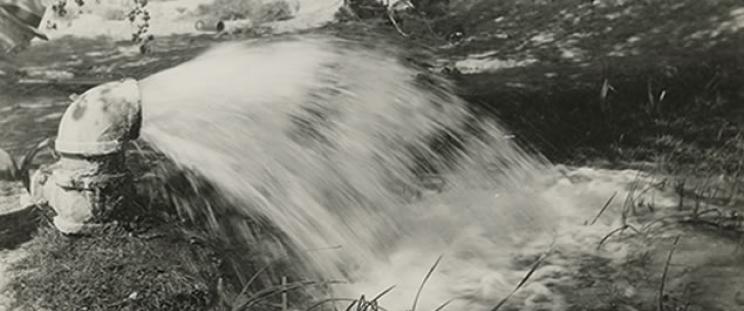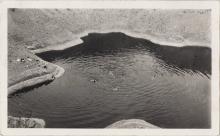Collection Paragraphs

Because the Water Company relied on what was at least initially an open and natural water supply flowing freely from springs, the risks of contamination were often a source of controversy between the city and the Water Company. While the company exercised what it considered due diligence in protecting and maintaining the water sources, the distance from the springs to the city and the exposure and vulnerability of the transmission lines were a cause of anxiety and frustration for Water Company officials and engineers, as outraged citizens complained to public health officials of frogs and lizards in their drinking water, and effluvia in the reservoirs. The railroad itself and public health officials regularly tested the water for contaminants.
For the most part the water supply was considered excellent if hard—the best in Nevada, according to one state official—and when piping water from Lake Mead to the city was publicly discussed after the war, one of the issues was the inferior quality of the water from Lake Mead.
“The largest cesspool in town and containing the human excretions of over 500 men daily, was on the 23nd and 23rd inst., emptied into the Las Vegas Creek, where a short distance below is located the fine herd of dairy cattle that supplies the milk for the citizens of Las Vegas. The cattle obtain all the water they drink from the creek . . . Near the slaughter house on the Las Vegas Ranch, is a fine lot of hogs that wallow in the water from the creek. The only supply of meat Las Vegas has is butchered in the slaughterhouse, and the meat must be washed with sewerage water . . “
J.T McWilliams, complaint to Clark County Commissioners, May 1912
I have made no comment, whatsoever, to anyone in connection to this paper, as the contents of same sound to me like absolute rot, but the non-thinking employee’s mind is being filled daily with such stuff as this . . .If it is not the water supply and the water mains, it is the sewer and septic tank business or something else in connection with the Company’s interests, and it is rather a hard battle to fight such things down, although they originated from a man of McWilliam’s caliber. . . I believe in this connection, as in all similar cases, the only thing to do is to absolutely say nothing and let matters work themselves out . . . “
Walter R. Bracken to H.I. Bettis, letter, May 24, 1912
“I anticipate trouble with him now for the next six months, or until the city sewer is completed or the location of the septic tank definitely decided. But in my opinion, being nothing but a foolish crank, I don’t think we should pay any attention to him, only to protect out rights when he brings such things up before the authorities.”
Walter R. Bracken to J. Ross Clark, letter, June 4, 1912

“I have made a careful investigation and find no good reason for complaint on the part of any citizen of this community . . . Las Vegas has never had a single case of sickness due to unsanitary culinary water, and I feel absolutely certain, there is no room for criticism at present regarding the Las Vegas Creek. If there was any excuse prior to two weeks ago, there is not now, as all defects have been remedied. The railroad has a great deal more at stake in this community than any other concern or individual, and I am sure would not knowingly do anything to endanger the health of the people living there.”
Dr. Roy Martin to the Nevada State Board of Health, letter, June 10, 1912
“I am sure that the railroad has done everything possible to maintain an adequate supply of pure water and to prevent any contamination that might result in unsanitary conditions there. . .”
Joseph Edward Stubbs, President of the University of Nevada, July 2, 1912
“The said reservoir is reported to be in a filthy and unclean condition, containing matter that tends to breed germs of disease. That the outlet from said reservoir into the pipes that convey the water top the water mains for distribution throughout the city is in such a state of decay that it allows frogs and other animal bodies to pass into said pipe and mains, and thus serve to pollute the water which is used in our homes for domestic use and drink. Therefore you are requested to give this matter your earliest and earnest attention . . . and make the said reservoir and source of water supply clean and free from impure matter when it enters said pipe and water mains.”
Henry M. Lillis, City Attorney, to Walter R. Bracken, letter, June 29, 1916
“The trouble has been temporarily corrected and the reservoir at present in good condition . . . there are now 3 screens and while they will have to be cleaned at least once a week, they will most certainly keep the frogs and filth from entering the main”
Bracken to H.C. Nutt, General Manager of the SP,LA & SL Railroad and President of the LVL&W Co., letter, August 2, 1916
“. . . it is imperative that something be done to improve the quality of the drinking water furnished to the citizens and employees at Las Vegas.”
Dr. Barr to Bracken, letter, July 14, 1916
“In this connection, we, of course, realize the importance of the water supply at Las Vegas, involving, as it does, the health of the entire community . . . I am arranging to ask for authority to put down an artesian well, which, together with the flow from Spring No. 1, we feel will give ample and pure water for the town of Las Vegas.”
W.H. Comstock to Governor J.G. Scrugham, letter, July 30, 1923
Inquiry:
What scientific advances in the mid- and late-1900s changed the definition of potable water and how have utility companies and the public responded to the increased knowledge?
“Roof over the reservoir, in my opinion is MOST ESSENTIAL . . All of our troubles in the past years with not only the state health department but with City and County officials were on account of the condition of the water which we held in the reservoir without being enclosed. The water, in time, even though with cement bottom, if exposed to sunlight, will become filled with moss and other growths and while this might not be injurious, yet to those using and drinking the water it will look not to be pure and healthy, and an uncovered reservoir is subject to much criticism. Migratory birds would always be using it, and to keep the town boys from using it as a swimming hole would be almost impossible.”
Walter R. Bracken to Howard C. Mann, Chief Engineer UP System, letter, April 26, 1928
“It is my opinion that the entire water supply should be chlorinated constantly as a safety measure, starting immediately.”
D.D. Carr, MD, Clark County Health official to A.M. Folger,letter, May 25, 1950
